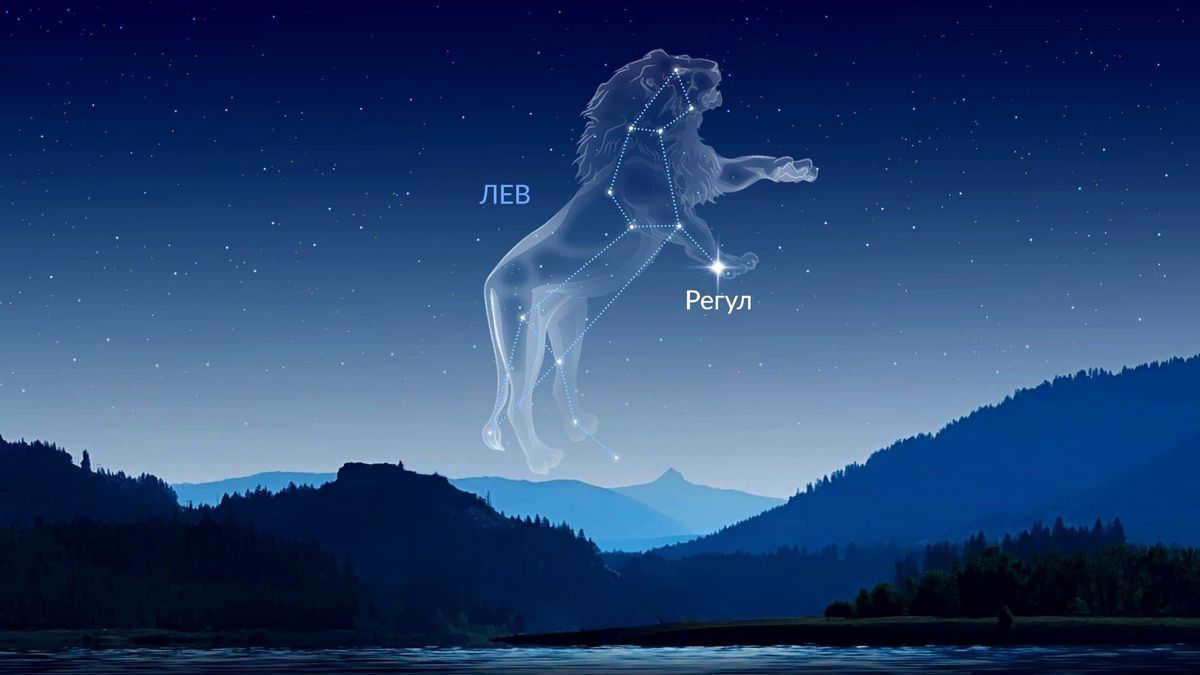
If you’ve ever pondered upon the possibility of the majestic rulers of yore watching over us from the celestial realm, let me introduce you to Regulus. Nestled within the constellation Leo, this celestial body bears the moniker “Little King” in Latin. However, even if you’re not inclined towards the mystical, Regulus remains a captivating entity to behold. Its radiant luminosity illuminates the night sky, effortlessly catching the eye even without the aid of sophisticated equipment. Delve into the following article to discover the precise means of locating Regulus amidst the vast expanse of the sky, and be sure not to overlook the intriguing revelations presented in the “Interesting Facts” section, which serve as testament to this star’s regal lineage.
Star Regulus (Alpha Leo) – key information about the star
- Official name: Regulus, Alpha Leo, α Leo
- Other names: Cor Leonis, Lion Heart, Kalb Al Asad.
- Catalog designations: 32 Leonis, HIP 49669, HR 3982, HD 87901, TYC 833-1381-1
- Constellation: Leo
- Star type: Main-sequence star of spectral class B7 V
- Right Ascension: 10 h 08 m 21.2 s
- Declination: +11° 58′ 06.3″
- Apparent magnitude: 1.4
- Mass: 3.8 solar masses
- Luminosity: 316.2 L
- Radius: 4.35 solar radii
- Temperature: 12,460 K
- Distance to Earth: 79.3 light years
- Rotation period: 16 hours
Regulus star system
Although Regulus appears to be a single star, it is actually a system of four stars that are grouped into two pairs. The first pair, known as Regulus A, consists of a blue main-sequence star of spectral type B8 and a presumed white main-sequence dwarf. The blue star is visible to the naked eye, while its partner has yet to be directly observed by anyone. Astronomers have predicted its existence using spectroscopic analysis.
If you happen to possess a diminutive telescope with a minimum of 50x magnification, you will be able to discern a tertiary celestial body within the Regulus system, aptly named Regulus B. This particular entity is an intriguingly cool orange dwarf star classified as belonging to the spectral type K2 V. Accompanying Regulus B is another stellar companion, designated as Regulus C, which happens to be a red dwarf star classified as spectral type M4V. In order to catch a glimpse of Regulus C, the aid of a formidable telescope is required.
How can I locate Regulus in the night sky?
Regulus is classified as the 21st brightest star in the celestial sphere. It can be found within the constellation Leo and is part of the renowned Spring Triangle asterism. With an apparent magnitude of 1.4, Regulus is easily discernible to the naked eye, making it unnecessary to use telescopes or binoculars.
Therefore, if you’re in search of a captivating celestial object that is both simple to locate and impressive to showcase to your companions, Regulus is an excellent option. Let’s now delve into the process of locating this dazzling star in the expansive sky above you.
Regulus is visible in the sky for most of the year, except for a brief period from early August to early September when it becomes too close to the Sun. Starting in mid-September, Regulus can be observed in the morning sky. Then, around mid-February, it becomes visible in the night sky. Regulus can be seen in both the Northern and Southern Hemispheres. Please note that in southern latitudes, the constellation Leo, where Regulus is located, appears inverted.
The optimal time to view Regulus is from late March to May when the star is at its highest point above the horizon.
What is the method to locate the most luminous star in the constellation Leo?
To locate Regulus in the night sky, the traditional approach involves determining its coordinates relative to other celestial objects. Regulus is situated within the asterism known as the Sickle of Leo, which bears a resemblance to a mirrored question mark. To find Regulus, direct your attention to the cluster of stars forming the Sickle in the region of the sky where the Moon and planets are observable (in close proximity to the ecliptic).
If you reside in the Northern Hemisphere, you may also utilize the renowned Big Dipper, which is an asterism derived from the Big Dipper, in order to locate the star. Simply draw an imaginary line connecting the two stars positioned on the outer edge of the bowl of the Great Ladle, specifically Dubhe and Merak. Subsequently, extend that line downward approximately eight times and you will inevitably encounter Regulus, which is the brightest star in that particular direction. It is crucial to bear in mind that planets also traverse nearby, so if you wish to avoid confusing Regulus with Venus, we recommend reading our article elucidating the distinction between planets and stars.
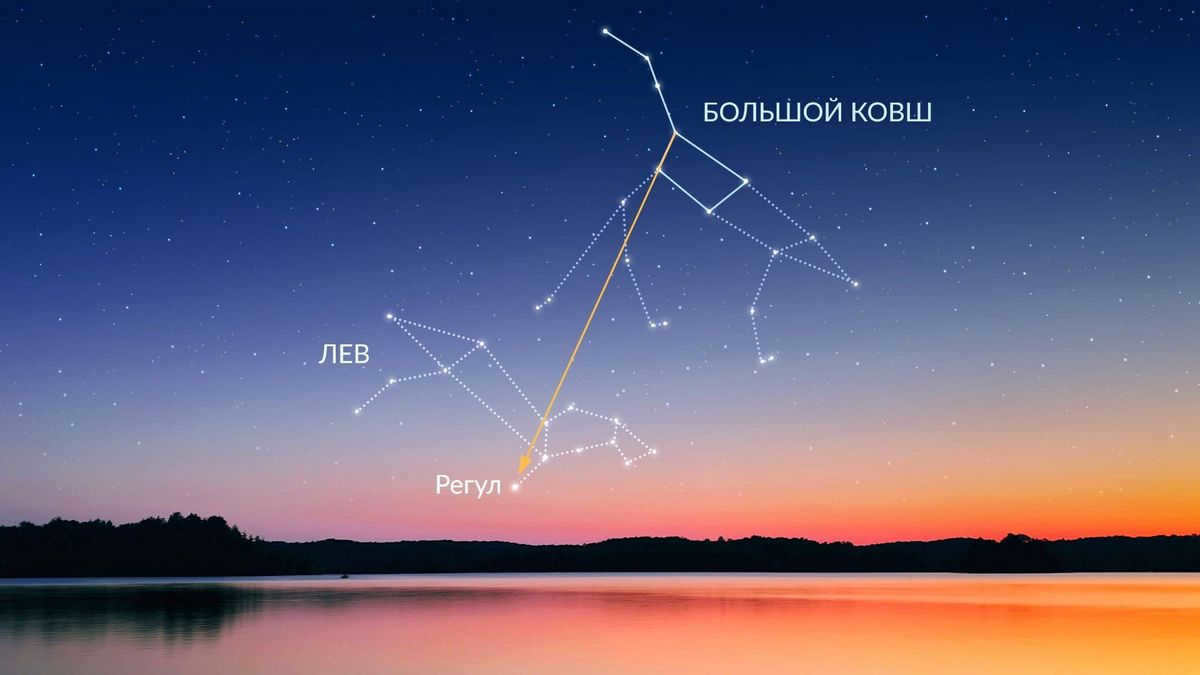
How to locate Regulus using Sky Tonight?
Exploring the night sky is a captivating activity, and it can be effortlessly accomplished with the aid of a suitable astronomy application like Sky Tonight. By following these simple steps, you can easily find Regulus:
- Launch the app’s search bar and enter “Regulus.”
- Click on the blue button with the target icon situated to the right of the search outcome. The app will display the star’s position on the celestial map.
- Tap the blue compass button located in the lower right corner of the screen. The app will utilize your device’s location to align the displayed image with the actual sky above you.
- Adjust the position of your device according to the direction indicated by the white arrow until you can locate Regulus on both the screen and the actual sky.
Aside from the prominent Regulus, Sky Tonight offers you the opportunity to explore numerous other celestial objects. Make sure to check out our video tutorials to optimize your experience with this application.
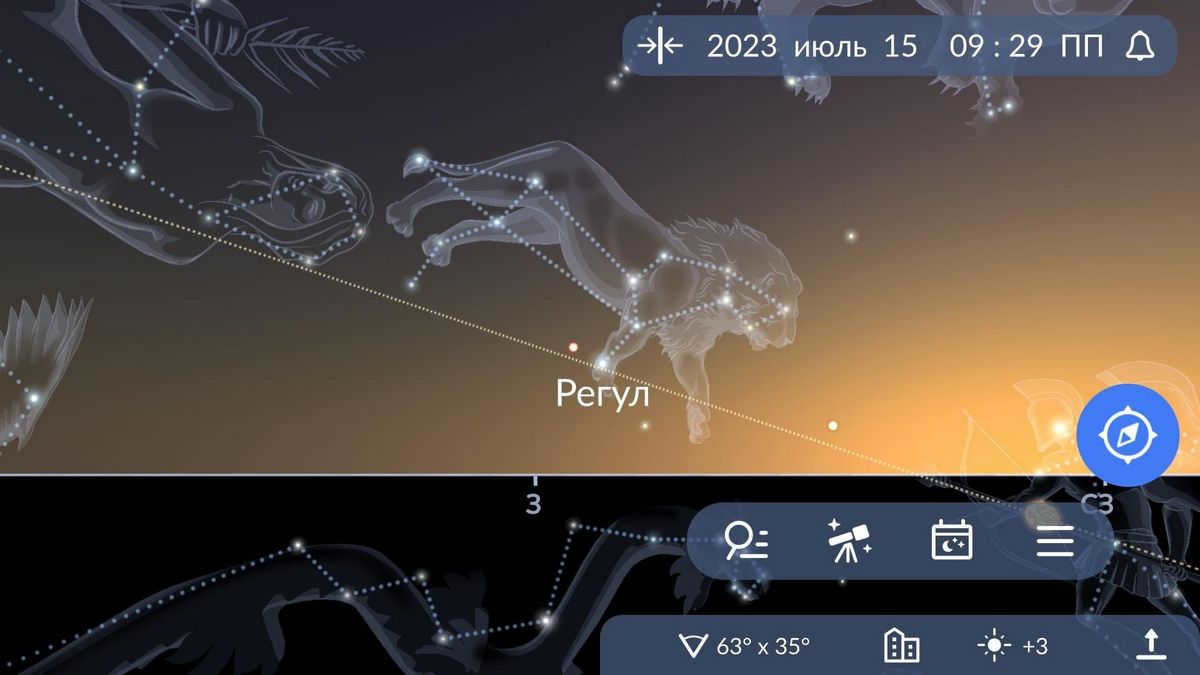
Engaging Trivia
Prince of the Stars
Recall the mention of illustrious monarchs at the commencement of this piece? There exist numerous explanations behind that. Firstly, Regulus signifies “Petite Ruler” in the language of ancient Rome. Secondly, this celestial body is a member of the Leo constellation, which is often associated with majestic lions, often referred to as “kings of the animal kingdom.” Numerous archaic designations for Regulus likewise underscore its regal lineage.
The star Cardia Leontos was known by different names in different cultures. The Greeks called it Cardia Leontos, the Latin name was Cor Leonis, and in Arabic it was called Kalb al-Asad. All three of these names mean “heart of a lion”. It is interesting to note that King Richard I of England was also known as Lionheart. But that’s not all! Regulus, as early as 3000 B.C., was highly esteemed. Babylonian astronomers called it Sharru, which means “king”. The Persians referred to it as Miyan, meaning “center”, and considered it one of the four royal stars. In India, this star was known as Magha, which means “the mighty one”. These various names and associations give us enough reason to believe in Regulus’ regal origins.
Mediastar
Regulus has captured the attention not only of ancient civilizations, but also of modern popular culture. This star has made appearances in well-known television series like Babylon 5 and Star Trek, as well as in popular computer games such as BattleTech, the Frontier series, and Descent: FreeSpace. Additionally, fans of J.K. Rowling’s Harry Potter book series may recall the character Regulus Black, who was the brother of Sirius Black, Harry’s godfather. It is interesting to note that Regulus Black’s name was inspired by the brightest star in the sky.
Swift and oval
Did you realize that not all celestial bodies are perfectly spherical? Consider Vega, for instance, which is compressed at the poles. And guess what? Our esteemed Regulus is even more fascinating – it has an egg-like shape! This peculiar form is a result of Regulus’ high-speed rotation. The star completes one full revolution around its axis approximately every 16 hours. In comparison, our Sun takes 27 days to complete one rotation.
Scientists have computed that if Regulus rotated just 10% faster, it would disintegrate. Nevertheless, there is no need to be concerned about the stability of our Star King. Researchers reassure us that nothing within this stellar system is capable of propelling Regulus to such a perilous velocity.
It has a close relationship with the moon and the planets.
Due to its position near the ecliptic, Regulus often crosses paths with the Sun, Moon, and planets. Occasionally, one of these celestial bodies obscures Regulus from our perspective – astronomers refer to this occurrence as a “covering”. The Moon is the most frequent coverer of Regulus, but there are also instances where planets take on this role. A notable example is on October 1, 2044, when Venus will cover Regulus. Make a note of this date!
Summing up
Having gained knowledge on locating Regulus in the night sky and marveling at the Star King independently, you now have two options. You can employ the Big Bucket technique or opt for the simpler approach by utilizing the Sky Tonight astronomy app. Regardless of the path you select, we wish you clear skies above and a fruitful stargazing experience! Enjoy your observation!
Approximately one hour after the sun goes down, the most brilliant star in the nocturnal firmament, Regulus, emerges. This particular star is classified as a first magnitude star and is considered one of the primary stars in our Milky Way galaxy. It can be found within the boundaries of the Leo constellation. By consulting a map of the celestial sphere, one can observe that it is positioned precisely at the focal point of the constellation, earning it the moniker of “Leo’s heart.”
The significance of the term “regulus”
The term “regulus” carries the meaning of “queen” or “prince” when translated from Latin. In Arabic, this star is referred to as “Kalb Al-Asad,” which can be translated as the “heart of the lion.” Occasionally, a Latin translation of this Arabic name can be found – Cor Leonis. It is believed that the term “regulus” originated from the name of this star. The definition of regulus is open to interpretation, as ancient astrologers believed that these are stars that rise and set on the same days.

Actually, Regulus cannot be classified as an individual star; rather, it is a system comprising four celestial bodies, with two being the primary ones. Regulus has a mass that is 3.5 times greater than that of the Sun, and its diameter is nearly four times larger. It is the most luminous star in the constellation, earning it the name Alpha Leo. Regulus is a fixed star, and its position directly on the ecliptic means that it rises and sets on nearly all latitudes (excluding the polar regions) on the same days. The best time to observe Regulus is during the spring, when there are fewer bright stars visible in the night sky compared to the summer. Scientists believe that Regulus is an ancient star, with an age exceeding 900 million years.
The historical significance of the star Regulus

Throughout history, the star has held significant importance in the field of astrology. Regulus is classified as a royal star and is one of the four prominent celestial stars. It is also known as the Guardian of the North, which is one of the celestial guardians. According to astrological legends, ancient Arab astrologers gave the name Guardians of the Sky to four bright stars that were stationary. Aldebaran was associated with the Guardian of the East, Antares with the Guardian of the West, and Fomalgaut with the Guardian of the South. These stars were situated in the vicinity of the equinoxes and solstices, which can be considered as markers on the celestial sphere. Regulus specifically marked the point of the summer solstice.
Astrological Significance of the Star Regulus
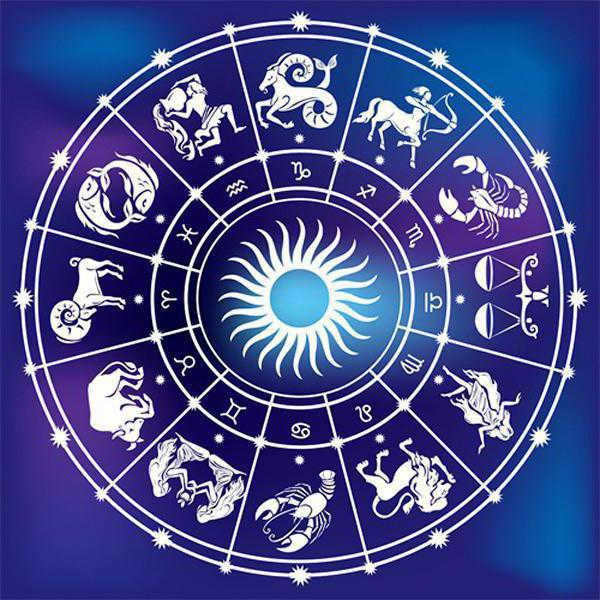
Astrologers from ancient times held the belief that individuals of great stature were born under the influence of this particular star. Nevertheless, Regulus possesses a dual impact on one’s horoscope. In most instances, its influence bestows significant advantages in life and resounding triumph in all undertakings. However, there is a possibility that it may also bring about sorrow.
The impact of Regulus on human destiny in astrology can be compared to that of Jupiter, Saturn, and Mars. When it aligns with Jupiter, Regulus aids individuals in attaining power, wealth, and success, although it also brings the possibility of a violent death or severe illness. On the other hand, when conjunct with Saturn, Regulus has an even more favorable influence on one’s fate, without indicating a painful demise. When aligned with the Sun, Regulus promises power and the fulfillment of nearly all desires. According to modern astrologers, Regulus assists individuals in displaying their will, developing courage, persistence, and nobility, while also creating space for the expression of their creative abilities.
The horoscope benefits from the star Regulus’ positive influence

The presence of the star in the 10th house of the horoscope is particularly advantageous. Its influence is evident through achievements in various endeavors, societal influence, rapid career growth, and significant wealth. Those who are favored by Regulus are accompanied by success in business, government, and military affairs, as well as connections with respected and famous individuals. The star aids in achieving victory and becoming the best in all matters, as long as the individual maintains generosity, nobility, and avoids abusing their power and strength. For individuals with Regulus in their natal chart, careers as military officers, politicians, public figures, bankers, lawyers, or clergymen are especially favorable.
Disadvantages of Regulus in the astrological chart

The presence of Regulus in astrology often leads to a strong desire to assert oneself at the expense of others, a need for dominance, and a tendency to portray oneself in a more favorable light, even if it leads to unfavorable consequences. Individuals under the influence of this star often display strength and power, which are prominent qualities in those with a strong placement of Regulus in their horoscope. These individuals also tend to be resistant to change and are often unwilling to alter their behavior, regardless of the potential negative outcomes that may arise from their actions.
Generally speaking, Regulus, as described above, is a fortunate celestial body that bestows power, high status, significant influence in society, and brings honor, fame, and success to its followers. However, it also demands from them a corresponding ambition, a global perspective on important matters, and a worldwide impact in their accomplishments. The influence of this star provides the opportunity to achieve outstanding results for individuals who have chosen military service, politics on a large scale, executive positions in big corporations, or professional sports. Regulus brings good fortune to individuals with grandiose ideas, characterized by open-mindedness and an unconventional approach to problem-solving.
So, what exactly is Regulus? It is the brightest star in the Leo constellation. We will delve into its characteristics and its position in the sky in the following sections.
The Leo Constellation
Situated in the northern hemisphere of the celestial sphere, between the constellations of Cancer and Virgo, lies the renowned zodiacal constellation of Leo. With a history dating back to ancient times, it is considered one of the oldest constellations ever identified. The ancient civilizations of India and Mesopotamia were well acquainted with this celestial formation, and its name, which translates to “Lion” in multiple languages, has been deciphered from their ancient texts.
The constellation’s shape undeniably resembles that of the majestic king of beasts. Its head, neck, and chest form a distinct semicircular pattern, known as the asterism “Sickle.” The most prominent star within the Leo constellation is Regulus, followed in brightness by Algieba, Denebola, Zosma, and Algenubi. Additionally, this celestial region includes a dimly illuminated red dwarf star known as Wolf 359, as well as a binary cataclysmic variable star system.
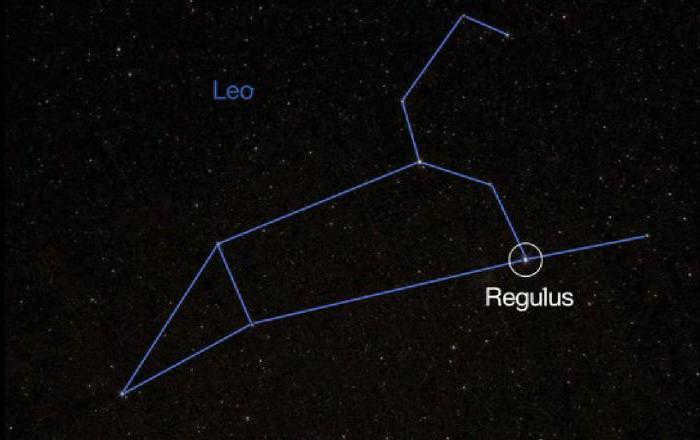
Leo is home to a variety of fascinating entities. During the middle of November, stargazers can witness the impressive Leonids meteor showers, which originate from the fragmentation of the Tempel-Tuttle comet. Additionally, this constellation houses numerous radiant galaxies, including M66, NGC 3628, and a gas cloud encircling a group of dwarf galaxies known as the Lion Ring.
What is Regulus?
Regulus, also known as Alpha Leonis, is a prominent star in the constellation Leo. It can be found at the southern end of the constellation, right where the Sickle asterism or inverted question mark terminates. Regulus is not only the brightest star in the zodiacal constellation, but it is also one of the most luminous stars in the entire sky. In terms of brightness, Regulus holds the 21st position among all celestial objects.
Being positioned near the ecliptic, Regulus experiences interesting celestial events. Every August, the Sun passes through Regulus, while the Moon occasionally obscures it from our view. In the spring sky, Regulus, along with Spica in Virgo and Arcturus in the constellation Boötes, stands out prominently among the other stars.
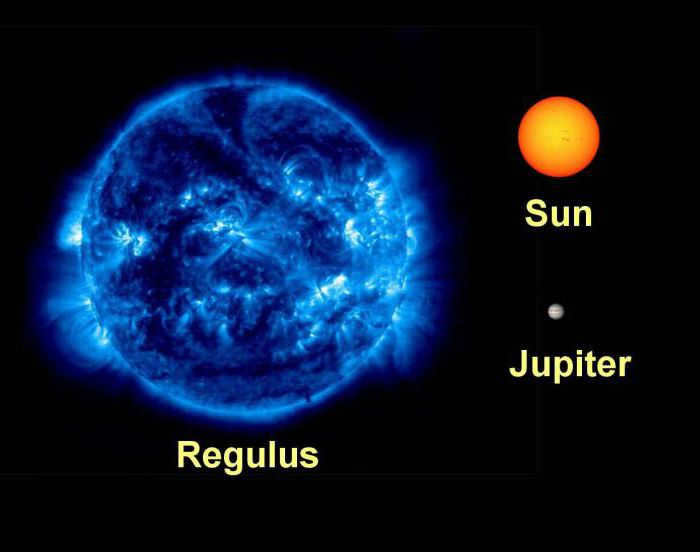
The weight of Regulus, a celestial body, is approximately 3.5 times greater than that of the Sun. It came into existence relatively recently and is considered to be quite youthful according to astronomical criteria. Regulus is located at a distance of 77.5 light years from the Solar System (one light year is equivalent to 9.4605 petameters). It shines with a brightness that is 141 times greater than our Sun and has a diameter four times larger.
Elements of the star
Regulus consists of multiple stars, totaling four in number. The primary star, known as Regulus A or the alpha of Leo, exhibits an exceptionally rapid rotation with a period of 15.9 hours. As a result, this star has an oblate shape, with its poles being five times hotter than its equator.
Regulus A is a bluish-white star that forms part of a binary system. It is gravitationally connected to another star, Regulus D, which serves as its companion in this system. Regulus D, on the other hand, is a white dwarf star that completes one revolution every 40 days.

The star has a remarkably low mass, measuring only 0.3 solar masses. Its existence was only detected in 2008, thanks to meticulous spectroscopic observations. The dwarf star is not discernible through a telescope, as it is obscured by the larger main star.
Located at a distance of 100 astronomical units, Regulus B and C form a binary system with an orbital period of approximately 2000 years. Regulus B is classified as an orange main-sequence star, while Regulus C is categorized as a red dwarf.
Name and symbolism
The identity and symbolism of Regulus have been known since ancient times, including by the Persians. According to Persian legends, Regulus was one of the four celestial guardians, along with Aldebaran in the Taurus constellation, Fomalhaut in the Southern Fish, and Antares in Scorpio. The Persians referred to Regulus as the guardian of the North, associating it with the mighty ruler Feridun. This star also marked the point of the summer solstice.
The Latin name “regulus” translates to “prince” or “king”. The same interpretation of the name was shared by the Arabs and the ancient Greeks. Ptolemy, for example, referred to the star as “Basilisk”, which means “king” or “lord”. As the main and brightest star in the constellation, Regulus is often known as the “Heart of the Lion”.
Astrologists ascribe great significance to the celestial body, asserting that the stars within the zodiacal constellations directly influence the destinies of individuals. It has been a longstanding belief that those under the patronage of Regulus possess exceptional strength, achievement, and drive. They are exceptional leaders, blessed with a spirit of benevolence and nobility.
How to identify Regulus?
Once you are familiar with what Regulus is, you can begin your search for it in the night sky. The task becomes easier if you are able to recognize the constellation Leo. Regulus can be found as the rightmost star in a trapezoid shape, which represents the body of Leo and consists of four bright stars. In the asterism known as the inverted question mark, Regulus serves as the final point at the bottom.
Located on the outermost edge and positioned at the lowest point of Leo, this star becomes visible in the sky starting from the month of January. During this time, it can be seen late in the evening. In February, it becomes visible shortly after sunset. However, the ideal period for observing Regulus is from March to April, as the constellation can be found in the southern part of the sky during these months.
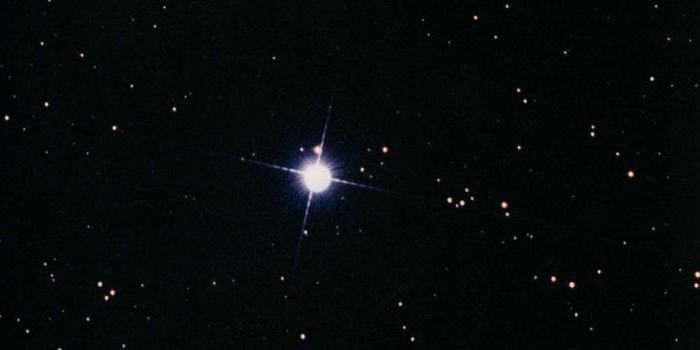
During the spring season, Regulus stands out as one of the most brilliant stars, emitting a radiant blue-white light. The star’s unique rotation places it in a perpendicular orientation to our line of sight, resulting in an observation from the side of its rib.
Regulus, also known as Alpha Leo, holds the title as the brightest star in the constellation Leo and ranks as the 21st brightest star in the entire sky. With an apparent magnitude of 1.35 and a distance of 79.3 light years, this celestial body is not just a single star, but a complete system.
The name “Regulus” finds its origins in the Latin language, meaning “little king” or “prince”.
Regulus A serves as the primary component of this system and is classified as a spectroscopic double star. It consists of a blue-white main-sequence star (B7 V) and a white dwarf. With a visual magnitude of 1.35, Regulus A contributes to the system’s blue hue.
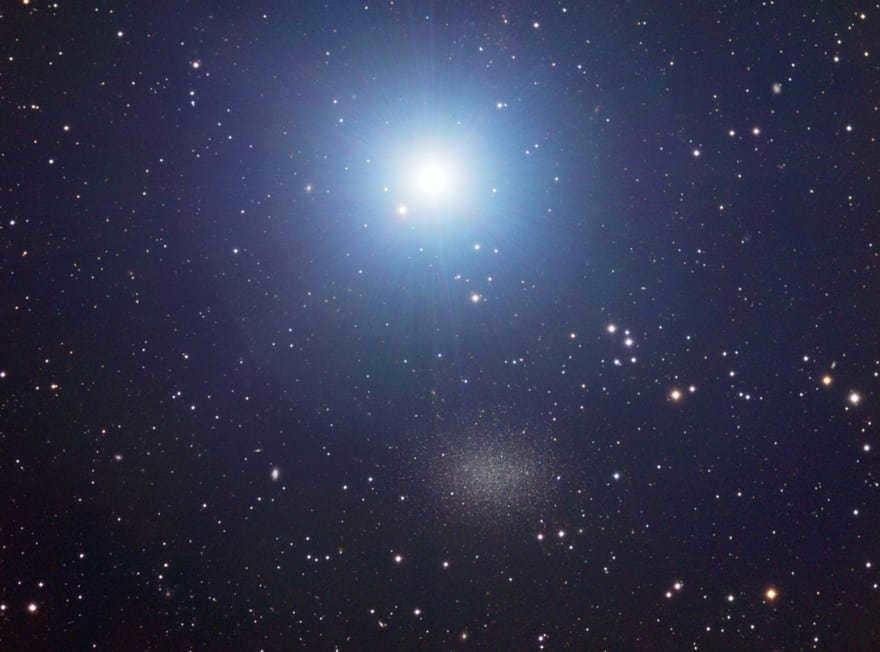
You can easily spot Regulus B using a pair of binoculars, but if you want to catch a glimpse of C, you’ll need to invest in a larger telescope. To make your search easier, we recommend using our online star map or a 3D model that shows the movement of Regulus in space.
Regulus is visible throughout the year, except in August when the Sun gets too close to its apparent location. Heliacal ascension occurs in the first week of September. Every 8 years, Venus passes in front of Regulus. The best time to observe this star from the northern hemisphere is during winter and early spring.
Facts
You are already aware of the constellation to which Regulus belongs. Now, let’s discover the hue of this star, its coordinates, and some intriguing details.
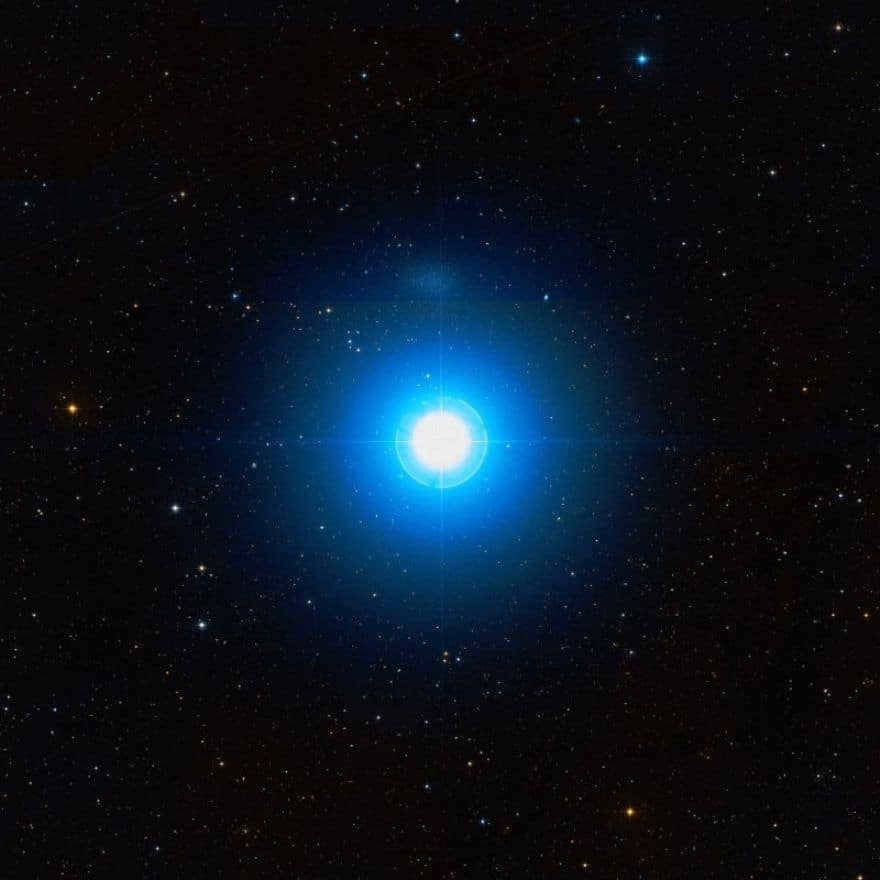
Regulus is positioned 0.46 degrees away from the ecliptic and is frequently obscured by the Moon. On occasion, it is also concealed by Mercury and Venus. The most recent overlap between Venus and the star occurred in 1959, and the next one is predicted for 2044.
Alpha Leo occasionally attracts asteroids. For instance, in 2014, the star was visited by 163 Erigon, a 73-kilometer-wide asteroid from the asteroid belt. Additionally, in 2005, the 54.6-kilometer-wide 166 Rodol approached Regulus.
Regulus has been recognized by various cultures. The modern name was derived from the Latin word “rex,” which means “king.” This name was chosen by Nicolaus Copernicus. The Arabs referred to it as Kalb al-Asadu, which translates to “the heart of the Lion.”
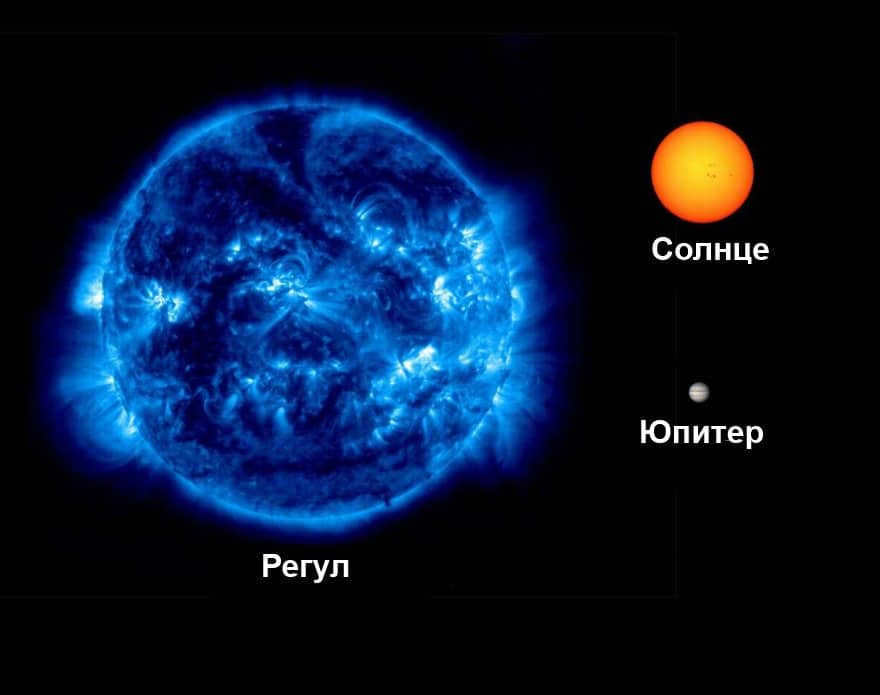
A comparison between the dimensions of Regulus, the Sun, and Jupiter
Known as Sharru (King) in Babylon, Miyan (Center) among the Persians, and Magha (Mighty) in India, Regulus held various titles in different cultures. In the medieval era, it was regarded as one of the 15 fixed stars of Begen, which had an impact on several planets.
This stellar body has made appearances in films like Babylon 5 and Star Trek, as well as in computer games such as BattleTech and Frontier: Elite II.
Stellar System
The Regulus stellar system consists of four distinct entities, forming two pairs. The more luminous component is designated as Regulus A, which is a binary system comprising a blue star and its white companion. These two stars orbit each other with a period of 40.11 days, at a distance of 0.35 astronomical units. The presence of the white companion was first observed in the year 2008.
The primary component of Regulus A possesses a mass approximately 3.8 times that of the Sun and is estimated to be a few million years old. It exhibits a rapid rotation rate of 347 km/s. Due to its fast rotation, the star’s shape becomes oblate, with its equatorial diameter being 32% larger than its polar diameter. If its rotational velocity were 10% higher, the star would disintegrate due to insufficient gravitational forces to hold it together. Consequently, the poles of the star are five times brighter and significantly hotter than the equatorial region.
The second set of stars, Regulus B and C, are identified as the dimmer stars in the main sequence (K1-2 V and M5 V). These stars are orange and red dwarfs that are located in front. The duration of their orbit is 2000 years and the distance between them extends to 100 astronomical units. Regulus C is positioned 177 angular seconds away from A.
Regulus, which can be found in the Leo constellation, moves quickly across the sky. It is part of the asterism known as the Sickle of Leo and indicates the lower portion of the handle. The shape of this asterism resembles an upside-down question mark. To locate it, one can use the stars of the Big Bucket in the Big Dipper constellation. Megretz and Thekda serve as guides to finding Regulus.
Physical attributes and path
- Regulus is the primary star in the constellation Leo.
- Spectral class: B7 V (A), K1-2 V (B), M5 V (C).
- Coordinates:
- Regulus A: 10h 08m 22.311s (right ascension), + 11° 58 ‘ 01.95″ (declination).
- Regulus BC: 10h 08m 12.8/14s (right ascension), + 11° 59 ‘ 48″ (declination).
- Distance: 79.3 light-years.
- Names: Regulus, Alpha Leo, Leon, Lion Heart, Rex, 32 Leo, Kalb al Asad, Cablebed, HR 3982, GJ 9316, HIP 49669, FK5 380, GCTP 2384.00.
- Reg A: HD 87901, SAO 98967, BD + 12 2149, LTT 12716.
- Reg B: HD 87884, SAO 98966, BD + 12 2147, LTT 12714.
- Apparent magnitude: 1.35 (A), 8.14 (B), 13.5 (C).
- Absolute magnitude: -0.52 (A), 6.3 (B), 11.6 (C).
- Mass: 3.8 solar masses (A), 0.8 (B), 0.2 (C).
- Size: 3.092 solar radii (A), 0.5 (B).
- Brightness: 288 solar luminosities (A), 0.31 (BC).
- Temperature: 12460 K (A).
- Speed of rotation: 347 km/s (A).
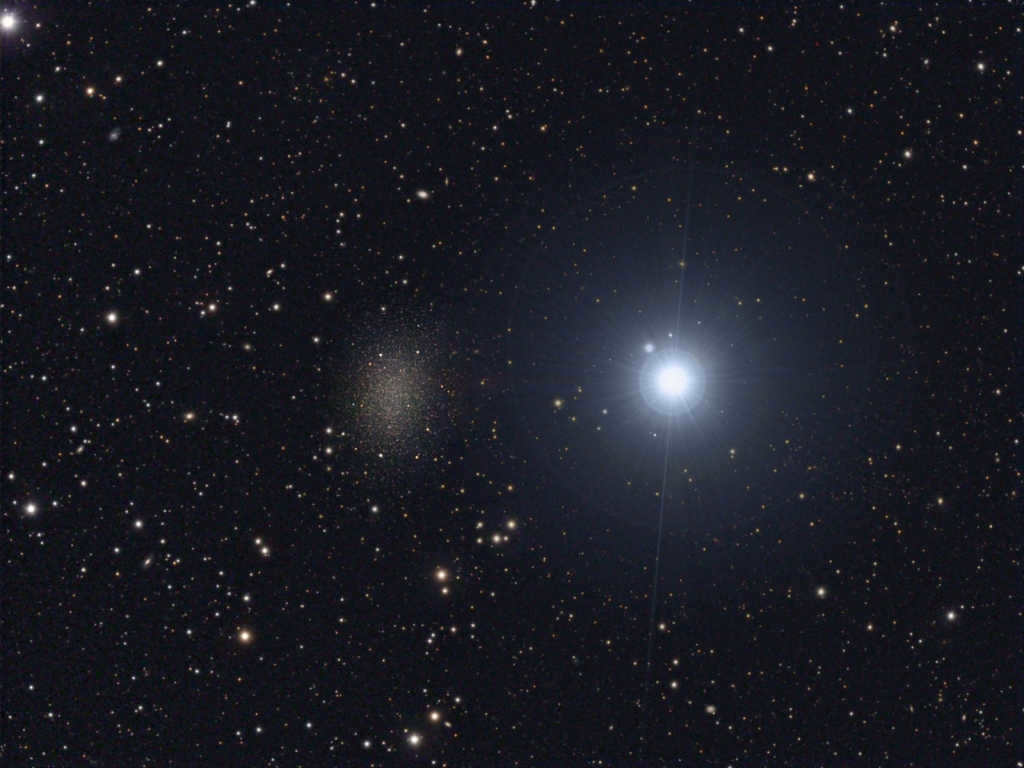
When gazing at the celestial dome during the vernal evening, it is evident to even the most inexperienced observer that three luminous celestial bodies shine more brightly than the others – these are Arcturus, Spica, and Regulus.
Regulus reigns as the monarch of the firmament
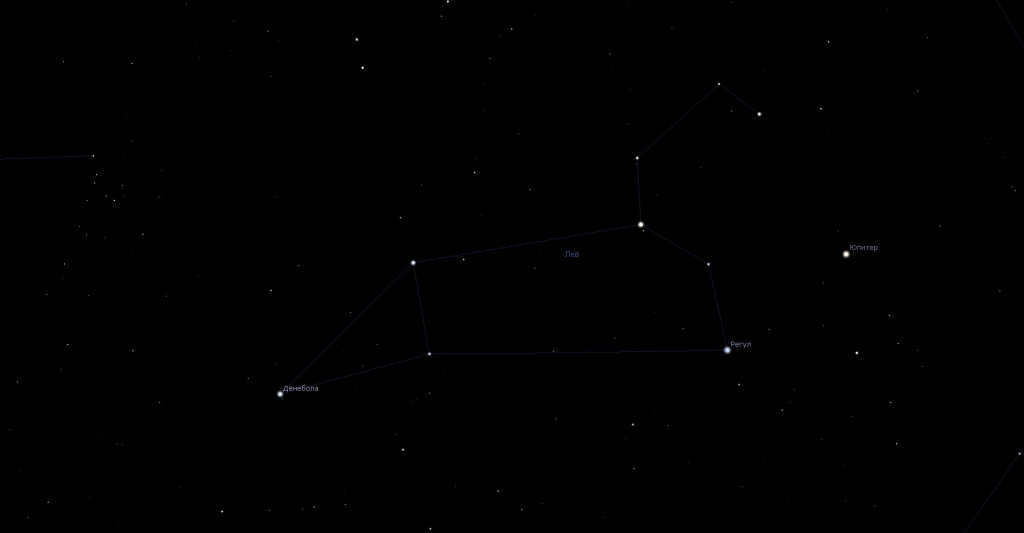
The constellation Leo and its alpha, Regulus.
Regulus, also known as the Alpha star of the Leo constellation, is one of the most prominent stars visible in the night sky. It shines brightest during the spring season when the night sky is less crowded with other bright stars compared to the summer months. However, observing Regulus in the summer can be challenging due to its proximity to the ecliptic, the path of the Sun in the sky. It is not uncommon for the Moon to obstruct the view of this celestial body.
Materials related to the subject
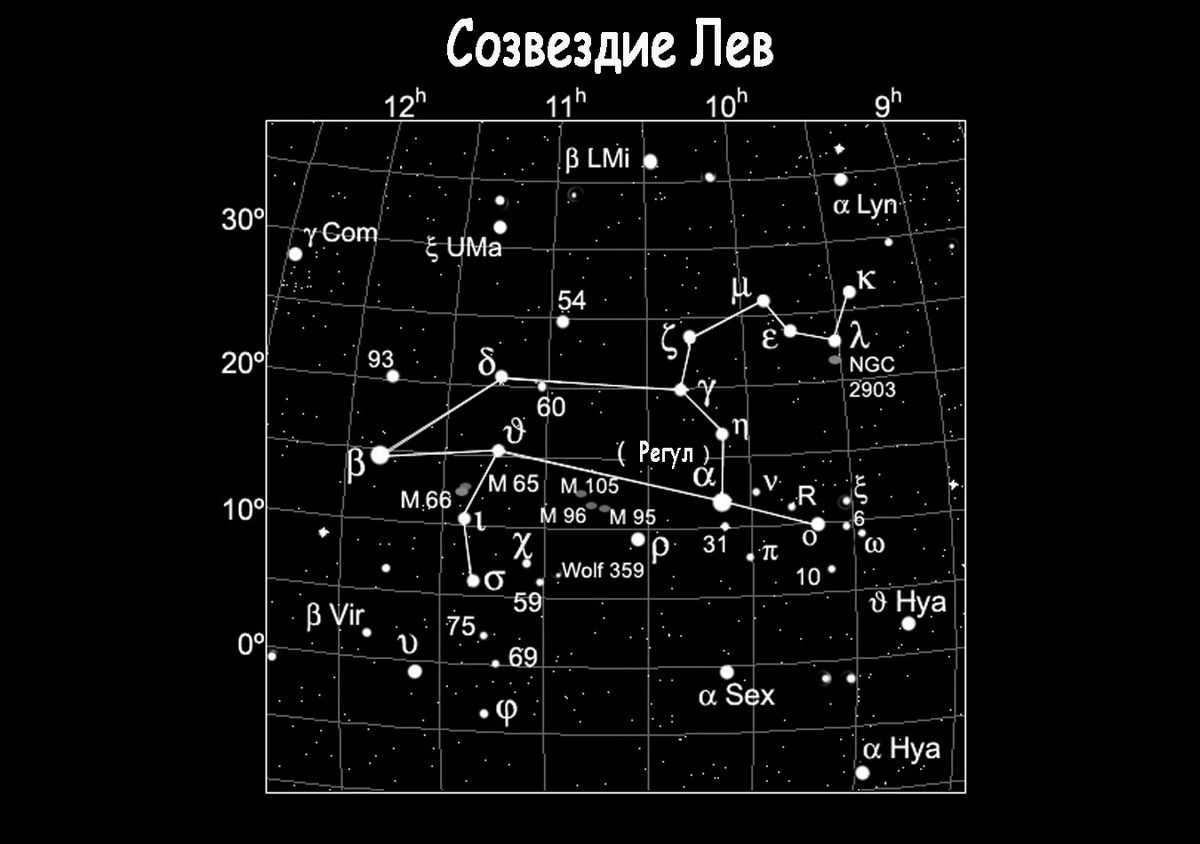

However, during the spring season, when Regulus is situated at a considerable distance from the ecliptic line, it can be readily identified amidst the numerous stars, even without the aid of optical instruments. This is primarily due to the exceptional luminosity of this particular celestial body.
Etymology and background of the detection
Being the 21st brightest star visible in the Northern Hemisphere, the star Regulus stands out clearly against the backdrop of the night sky. It is inevitable that a star of such brightness would attract attention. The earliest reference to Regulus can be found in ancient Arabic texts, which were written centuries before the start of our era. In these texts, the star is referred to as “Kalb Al-Asad”, meaning “the heart of a lion” in Arabic. However, the star got its name Regulus from the Latin language. It was European astronomers who first dubbed it “Regulus”, a name that has since become universally recognized. In Latin, “regulus” (Latin. regulus) translates to “prince” or “tsarek”. Indeed, gazing at this radiant star, one can envision an Arab prince proudly strolling alongside Leo.
Because it is the most luminous star in the Leo constellation, it is also known as Alpha Leo. This name corresponds to its astronomical designation, “α Leo,” which is its commonly recognized astronomical name.
The unique form and speed of rotation of the star
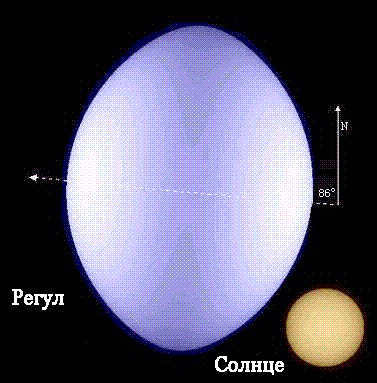
The star Regulus is of great interest to amateur astronomers due to its unique shape, as well as its exceptional brightness. Unlike our Sun, which rotates at a much slower pace, Regulus spins at an incredible speed of 315 km/s. This rapid rotation has caused the star to take on a flattened shape, with its equatorial radius being almost one-third larger than its polar radius. In fact, Regulus completes a full rotation in less than 16 hours.
It is fascinating to consider that if Regulus were to rotate just 14 percent faster, at a speed of 359.1 km/s, the centripetal gravitational force acting on the star would not be sufficient to maintain its structure. In such a scenario, the star would simply collapse.
Unlike the majority of stars, Regulus has a tilted axis of rotation, resulting in us perceiving this celestial object from a unique perspective. As a result of its rapid rotation, the pole region of the star is approximately half as hot as the equator and shines five times brighter. Interestingly, the axis of rotation of Regulus aligns with its orbital path, causing Regulus to appear as if it is moving on its side along its orbit. This phenomenon is a captivating astronomical occurrence.
Mass and age
The weight and age of an object are closely related. The mass of an object refers to the amount of matter it contains, while age refers to the length of time that has passed since its creation or birth. These two factors can have a significant impact on the characteristics and behavior of an object. As an object ages, it may gain or lose mass through various processes such as growth, decay, or erosion. Additionally, the age of an object can affect its physical properties, such as its strength, durability, and overall condition. Therefore, understanding the relationship between mass and age is crucial for analyzing and predicting the behavior of objects in various fields, including physics, biology, and geology.
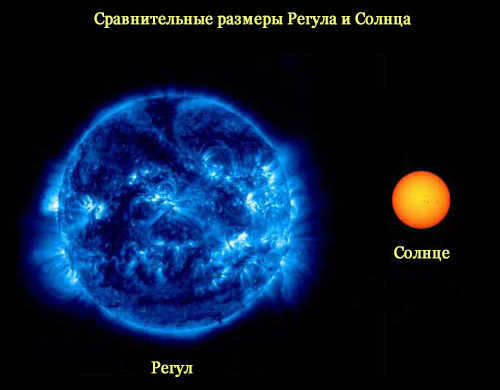
Comparison of the sizes of Regulus and the Sun
According to the calculations made by contemporary physicists and astronomers, Regulus is considered to be a significantly massive star. A consensus among scientists is that the mass of Regulus is three and a half times greater than that of the Sun.
When it comes to the age of the star Regulus, scientists have not always had a unanimous opinion. In the past, it was thought that Regulus was no older than 100 million years, which would make it a young star. However, in 2008, scientists found a dwarf star, Regulus D, in close proximity to Regulus. This discovery led scientists to believe that Regulus is actually much older than previously believed.
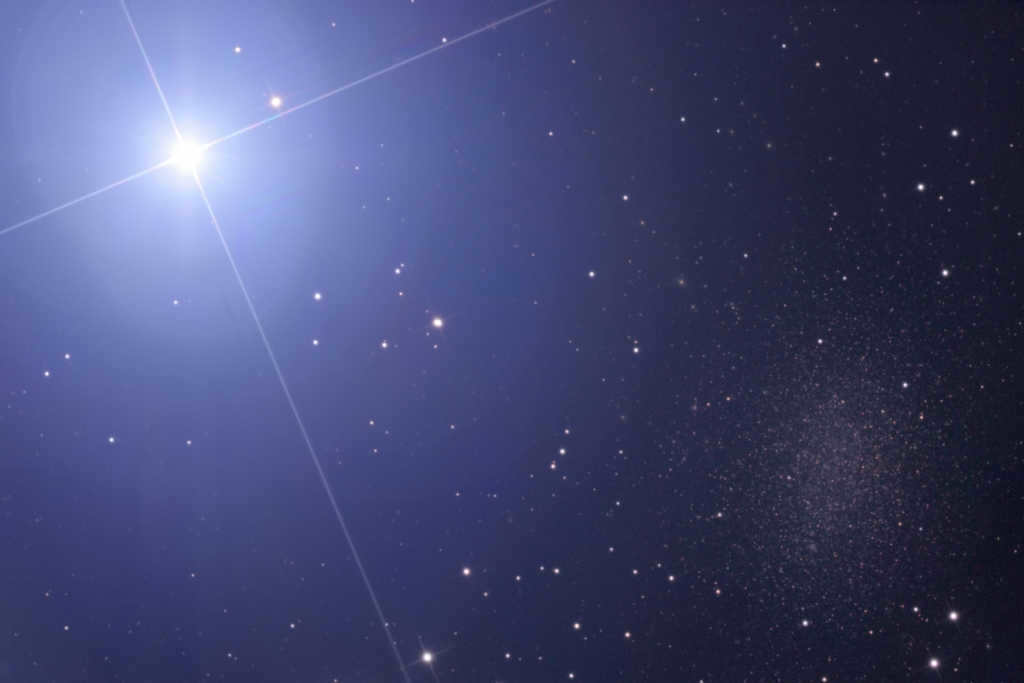
Methods for Identifying Regulus in the Night Sky
Identifying Regulus in the night sky is a relatively simple task due to its status as one of the most luminous stars. Not only can it be found within the boundaries of the Leo constellation, but it also serves as the foundation for the well-known asterism known as the Sickle, which can be easily spotted in the Northern Hemisphere. By simply looking upwards, you will be met with a gathering of stars that form the shape of a sickle or an inverted question mark. Positioned at the lowest point of this celestial arrangement is none other than Regulus itself.
Compilation of the most luminous stars
| 0 | Sun | 0.0000158 | −26.72 | 4.8 | G2V | |
| 1 | Sirius (α of the Big Dog) | 8.6 | −1.46 | 1.4 | A1Vm | Southern |
| 2 | Canopus (α of Kiel) | 310 | −0.72 | −5.53 | A9II | South |
| 3 | Toliman (α Centauri) | 4.3 | −0.27 | 4.06 | G2V+K1V | South |
| 4 | Arcturus (α Volopas) | 34 | −0.04 | −0.3 | K1.5IIIp | North |
| 5 | Vega (α Lyra) | 25 | 0.03 (perm) | 0.6 | A0Va | North |
| 6 | Capella (α Ascendant) | 41 | 0.08 | −0.5 | G6III + G2III | North |
| 7 | Rigel (β Orion) | ~870 | 0.12 (rem) | −7 | B8Iae | South |
| 8 | Procyon (α of the Lesser Dog) | 11.4 | 0.38 | 2.6 | F5IV-V | North |
| 9 | Ahernar (α Eridanus) | 69 | 0.46 | −1.3 | B3Vnp | South |
| 10 | Betelgeuse (α Orion) | ~530 | 0.50 (perm) | −5.14 | M2Iab | North |
| 11 | Hadar (β Centauri) | ~400 | 0.61 (perm) | −4.4 | B1III | South |
| 12 | Altair (α of Eagle) | 16 | 0.77 | 2.3 | A7Vn | Northern |
| 13 | Acrux (α of the Southern Cross) | ~330 | 0.79 | −4.6 | B0.5Iv + B1Vn | South |
| 14 | Aldebaran (α Taurus) | 60 | 0.85 (rem) | −0.3 | K5III | North |
| 15 | Antares (α Scorpio) | ~610 | 0.96 (perm) | −5.2 | M1.5Iab | South |
| 16 | Spica (α Virgo) | 250 | 0.98 (perm) | −3.2 | B1V | Southern |
| 17 | Pollux (β Gemini) | 40 | 1.14 | 0.7 | K0IIIb | Northern |
| 18 | Fomalgaut (α of South Pisces) | 22 | 1.16 | 2.0 | A3Va | Southern |
| 19 | Mimosa (β of Southern Cross) | ~290 | 1.25 (perm) | −4.7 | B0.5III | Southern |
| 20 | Deneb (α of the Swan) | ~1550 | 1.25 | −7.2 | A2Ia | Northern |
| 21 | Regulus (α Leo) | 69 | 1.35 | −0.3 | B7Vn | Northern |
| 22 | Adara (ε of the Great Dog) | ~400 | 1.50 | −4.8 | B2II | South |
| 23 | Castor (α Gemini) | 49 | 1.57 | 0.5 | A1V + A2V | Northern |
| 24 | Hakrux (γ Southern Cross) | 120 | 1.63 (perm) | −1.2 | M3.5III | South |
| 25 | Shaula (λ of Scorpio) | 330 | 1.63 (perm) | −3.5 | B1.5IV | Southern |





